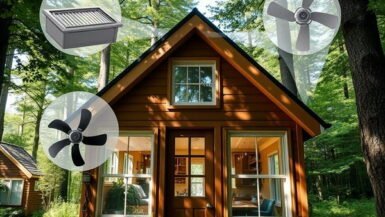In today’s rapidly evolving world, the concept of sustainable living has become a crucial aspect of our lives. As we strive to reduce our carbon footprint, tiny homes have emerged as an excellent solution to address our ecological concerns. In this informative article, we will delve into the world of energy efficiency, and how smart technology can play an instrumental role in optimizing the sustainability of your tiny home. We will discuss various innovative solutions, from solar panels and insulation to smart thermostats and energy-efficient appliances, that can significantly minimize energy consumption, lower costs, and ultimately contribute to the well-being of our planet. Join us as we explore the potential of integrating these cutting-edge technologies into your tiny home to create a harmonious balance between modern living and environmental stewardship.
Smart Lighting Solutions for Tiny Homes: Energy-saving Tips and Tricks
One of the most significant factors contributing to energy consumption in any home is lighting. With the right approach and smart technology, you can significantly reduce energy consumption and costs in your tiny home. In this section, we will explore various energy-saving tips and tricks, from choosing the appropriate light bulbs to integrating smart lighting systems, that can help enhance your tiny home’s efficiency and sustainability.
Choosing Energy-efficient Light Bulbs
The first step in creating a more energy-efficient tiny home is selecting the right light bulbs. Traditional incandescent bulbs are notorious for wasting energy, as they convert only a small fraction of electricity into visible light. Instead, opt for LED or compact fluorescent (CFL) bulbs, which consume up to 80% less energy than incandescent bulbs and last much longer. By making this simple switch, you can significantly reduce your energy consumption and overall carbon footprint.
Maximize Natural Light
Utilizing natural light in your tiny home can drastically reduce your reliance on artificial lighting. Consider installing large windows and skylights to allow sunlight to penetrate your living space. Additionally, using light-colored paint, reflective surfaces, and strategically placed mirrors can help distribute natural light throughout your home, further reducing the need for artificial lighting during daytime hours.
Integrating Smart Lighting Systems
One of the most effective ways to optimize energy efficiency in your tiny home is by incorporating smart lighting systems. These systems allow you to control your lighting remotely, create customized schedules, and adjust the brightness of your lights according to your needs. Some smart lighting systems even come equipped with sensors that detect when a room is occupied, automatically turning lights on or off to conserve energy. By integrating these intelligent solutions into your tiny home, you can significantly reduce energy waste and lower your electricity bills.
Implementing Task and Ambient Lighting
Rather than relying on a single, overhead light source, consider installing task and ambient lighting in your tiny home. Task lighting focuses on specific areas where activities take place, such as reading, cooking, or working on your laptop. Ambient lighting, on the other hand, provides a soft, general illumination throughout your living space. By implementing these targeted lighting solutions, you can avoid over-illuminating your entire home and thereby conserve energy.
Embracing smart lighting solutions is a crucial step in making your tiny home more energy-efficient and sustainable. By adopting energy-saving light bulbs, maximizing natural light, and integrating smart technology and targeted lighting strategies, you can significantly reduce your energy consumption and contribute to a healthier planet. As you continue to explore the world of sustainable living, consider incorporating these energy-saving tips and tricks into your tiny home to create a more environmentally-friendly and cost-effective living space.
Efficient Heating and Cooling Systems: Integrating Smart Thermostats in Tiny Houses
When it comes to maintaining a comfortable living environment in your tiny home, having an efficient heating and cooling system is essential. As energy consumption for heating and cooling often accounts for a significant portion of a household’s energy use, it’s crucial to find ways to optimize these systems for better efficiency and reduced energy costs. In this section, we will discuss the benefits of integrating smart thermostats into your tiny home’s heating and cooling system and explore other complementary strategies to maximize energy efficiency.
Understanding the Benefits of Smart Thermostats
Smart thermostats are a game-changer for tiny home owners looking to improve their energy efficiency. These innovative devices allow you to remotely control your home’s temperature, create customized schedules, and monitor your energy usage. By learning your habits and preferences, smart thermostats can automatically adjust the temperature to ensure optimal comfort while conserving energy. Additionally, some smart thermostats are compatible with other smart home devices, such as smart lighting systems and window blinds, to help you create a fully integrated and energy-efficient living space.
Choosing the Right Smart Thermostat for Your Tiny Home
With various smart thermostat models available on the market, it’s essential to carefully consider your specific needs and preferences before making a decision. When selecting a smart thermostat for your tiny home, consider factors such as compatibility with your existing heating and cooling system, ease of installation, and the availability of additional features, such as voice control and geofencing capabilities. By selecting a thermostat that best suits your needs, you can ensure seamless integration with your tiny home’s existing infrastructure and maximize energy savings.
Complementing Smart Thermostats with Insulation and Passive Design
While integrating a smart thermostat into your tiny home’s heating and cooling system can significantly improve energy efficiency, it’s also essential to address other factors that may impact your home’s overall thermal performance. Investing in proper insulation and adopting passive design strategies can help maintain a comfortable indoor temperature while minimizing the need for active heating and cooling. For example, using high-quality insulation materials, such as spray foam or rigid foam boards, can effectively reduce heat transfer between your home’s interior and exterior. Additionally, incorporating passive design elements, such as well-placed windows and shading devices, can help regulate your home’s temperature naturally, further reducing your reliance on active heating and cooling systems.
Integrating smart thermostats into your tiny home’s heating and cooling system is an effective way to enhance energy efficiency and reduce energy costs. By understanding the benefits of these innovative devices, selecting the right thermostat for your needs, and complementing their capabilities with proper insulation and passive design strategies, you can create a comfortable and sustainable living environment that aligns with your ecological values. As you continue to explore the world of tiny living, consider incorporating these energy-saving solutions to optimize your home’s thermal performance and contribute to a greener future.
Harnessing Solar Power: Installing Smart Solar Panels for Tiny Home Energy Efficiency
As the demand for clean, renewable energy sources grows, solar power has emerged as an attractive solution for homeowners looking to reduce their carbon footprint and increase energy efficiency. In this section, we will explore the benefits of installing smart solar panels in your tiny home, as well as discuss essential factors to consider when selecting and integrating these eco-friendly systems into your living space. By harnessing the power of the sun, you can create a sustainable and energy-efficient tiny home that aligns with your environmental values.
Why Smart Solar Panels Are a Great Option for Tiny Homes
Smart solar panels offer numerous advantages for tiny home owners seeking to improve their energy efficiency. These cutting-edge systems not only generate clean, renewable energy but also come equipped with advanced features, such as remote monitoring and performance tracking, that enable you to optimize energy production and consumption. By installing smart solar panels, you can reduce your reliance on traditional energy sources, lower your electricity bills, and contribute to a greener planet.
Selecting the Right Solar Panel System for Your Tiny Home
When considering a solar panel system for your tiny home, it’s crucial to evaluate various factors, such as your energy consumption, budget, and available roof space. Assess your energy needs by analyzing your monthly electricity usage and determining the optimal system size to meet those demands. Additionally, research different types of solar panels, such as monocrystalline, polycrystalline, and thin-film, to find the best fit for your home’s aesthetic and performance requirements. By carefully considering these factors, you can select the most appropriate solar panel system for your tiny home and maximize energy efficiency.
Maximizing Solar Energy Production with Smart Technology
One of the primary benefits of smart solar panels is their ability to communicate with other smart devices, such as energy management systems and smart appliances. By integrating your solar panel system with these technologies, you can optimize energy production and consumption, ensuring that your tiny home operates as efficiently as possible. For example, a smart energy management system can automatically adjust your appliances’ usage based on real-time solar energy production, minimizing the need for grid-supplied electricity. This interconnected approach to energy management can significantly enhance your tiny home’s overall energy efficiency.
Considering Additional Factors for a Successful Solar Panel Installation
Before embarking on a solar panel installation project, it’s essential to be aware of additional factors that may impact the success of your system. First, research local regulations and permitting requirements, as some areas may have specific guidelines or restrictions related to solar panel installations. Additionally, consider factors such as your home’s orientation, shading, and roof condition, as these can impact the performance of your solar panel system. By addressing these considerations, you can ensure a smooth and successful installation process and maximize your tiny home’s solar energy potential.
By installing smart solar panels, you can significantly improve your tiny home’s energy efficiency and sustainability. By understanding the benefits of these systems, selecting the right solar panel system for your needs, and integrating smart technology to optimize energy production and consumption, you can create a tiny home that is both eco-friendly and cost-effective. Harness the power of the sun and transform your tiny home into a shining example of sustainable living.
Sustainable Water Management: Utilizing Smart Water Systems in Your Tiny Home
Water conservation is a crucial aspect of sustainable living, especially in tiny homes where resources are limited. Embracing smart water systems can not only help you conserve water but also reduce energy consumption and costs associated with heating and pumping water. In this section, we will explore various smart water management solutions, including smart faucets, rainwater harvesting systems, and greywater recycling, to help you optimize your tiny home’s water usage and contribute to the preservation of this critical resource.
Smart Faucets and Showerheads: Saving Water with Every Drop
One of the simplest ways to conserve water in your tiny home is by installing smart faucets and showerheads. These innovative devices use advanced technology, such as flow restrictors and motion sensors, to reduce water flow and minimize wastage. For instance, smart faucets can automatically shut off when not in use or regulate water flow based on the task being performed, such as handwashing or dishwashing. Similarly, smart showerheads can adjust water pressure and temperature according to your preferences, ensuring that you enjoy a comfortable shower while using less water and energy.
Harvesting Rainwater: Making the Most of Nature’s Bounty
Integrating a rainwater harvesting system into your tiny home can be an excellent way to collect and utilize free, environmentally-friendly water for various purposes. Rainwater can be used for watering plants, flushing toilets, and even washing clothes, significantly reducing your reliance on municipal water supplies. To set up a rainwater harvesting system, consider installing gutters and downspouts to collect rainwater from your roof, and store the collected water in a tank or barrel. Be sure to include a filtration system to remove debris and ensure water quality for your intended purposes.
Greywater Recycling: Turning Waste into a Resource
Greywater recycling involves reusing water from sources such as sinks, showers, and washing machines for non-potable purposes. By implementing a greywater recycling system in your tiny home, you can significantly reduce your overall water consumption and lower your utility bills. To create a greywater recycling system, separate greywater from blackwater (sewage) and direct it to a treatment system, such as a constructed wetland or filtration unit. Once treated, the greywater can be used for irrigation, toilet flushing, or even laundry, depending on the level of treatment provided.
Monitoring and Managing Water Usage with Smart Technology
Keeping track of your water consumption is vital for managing your tiny home’s water usage effectively. Smart water meters and monitoring systems can provide real-time data on your water usage, helping you identify areas where you can conserve water and reduce waste. These systems can also alert you to potential leaks or unusual water usage patterns, allowing you to address issues promptly and prevent further wastage.
By embracing smart water systems and sustainable water management practices, you can significantly improve your tiny home’s water efficiency and contribute to the preservation of this precious resource. From smart faucets and showerheads to rainwater harvesting and greywater recycling, these innovative solutions can help you optimize your water usage, reduce your environmental impact, and lower your utility bills, creating a more sustainable and eco-friendly tiny home for you and future generations to enjoy.
Smart Home Appliances: Choosing Energy-efficient Devices for Tiny Living
When it comes to creating an energy-efficient tiny home, selecting the right appliances is crucial. Smart home appliances not only offer convenience and connectivity but also help reduce energy consumption and minimize environmental impact. In this section, we will explore various factors to consider when choosing energy-efficient smart appliances for your tiny home, and discuss some examples of devices that can help you save energy and create a more sustainable living space.
Understanding Energy Star Ratings and Energy Efficiency Labels
One of the most important factors to consider when selecting smart appliances for your tiny home is their energy efficiency. Energy Star ratings and energy efficiency labels provide valuable information about the energy consumption of different appliances, allowing you to make informed decisions about which devices will be most beneficial for your tiny home. Look for appliances with high Energy Star ratings, as these devices are designed to consume less energy and perform more efficiently than their non-certified counterparts. By choosing energy-efficient smart appliances, you can significantly reduce your energy consumption and contribute to a greener planet.
Opting for Multi-functional and Space-saving Appliances
Space is a valuable commodity in tiny homes, making it vital to choose appliances that are both functional and space-efficient. Multi-functional smart appliances, such as combination washer-dryers or refrigerator-freezer units, can help you save space while providing the convenience of multiple devices in one. Additionally, selecting appliances that can be easily stored or incorporated into your tiny home’s design, such as wall-mounted or under-counter devices, can help you make the most of your limited living space while maintaining energy efficiency.
Considering Smart Home Integration and Connectivity
When selecting smart appliances for your tiny home, it’s essential to consider their compatibility with your existing smart home system and other connected devices. Integrating your appliances with a smart home hub, such as Google Home or Amazon Alexa, can provide you with centralized control over your devices, allowing you to monitor and manage your energy consumption more effectively. Additionally, choosing appliances that are compatible with smart plugs or energy management systems can help you optimize energy usage by automatically adjusting settings based on factors such as energy production, time of day, or even weather conditions.
Examples of Energy-efficient Smart Appliances for Tiny Homes
There are various energy-efficient smart appliances on the market that can enhance your tiny home’s sustainability and provide you with the convenience of modern living. Some examples include:
- Smart refrigerators: These appliances can optimize energy consumption by adjusting temperature settings based on the contents of your fridge, and even provide you with energy usage data and alerts for maintenance or potential issues.
- Smart washing machines: By detecting the size of your laundry load and the level of dirt, these devices can automatically adjust water and energy consumption, ensuring optimal efficiency with every wash.
- Smart air purifiers: These devices can monitor air quality in real-time, adjusting settings as needed to maintain optimal air quality while conserving energy.
- Smart thermostats: As mentioned earlier, these devices can learn your habits and preferences, automatically adjusting your heating and cooling settings to conserve energy while maintaining a comfortable living environment.
By carefully selecting energy-efficient smart appliances for your tiny home, you can optimize energy consumption, reduce your environmental impact, and create a more sustainable living space. By understanding energy efficiency ratings, choosing multi-functional and space-saving devices, and considering smart home integration, you can make informed decisions about the best appliances for your tiny home. Embrace the world of smart technology and transform your tiny living experience into an eco-friendly and energy-efficient haven.





Leave a reply